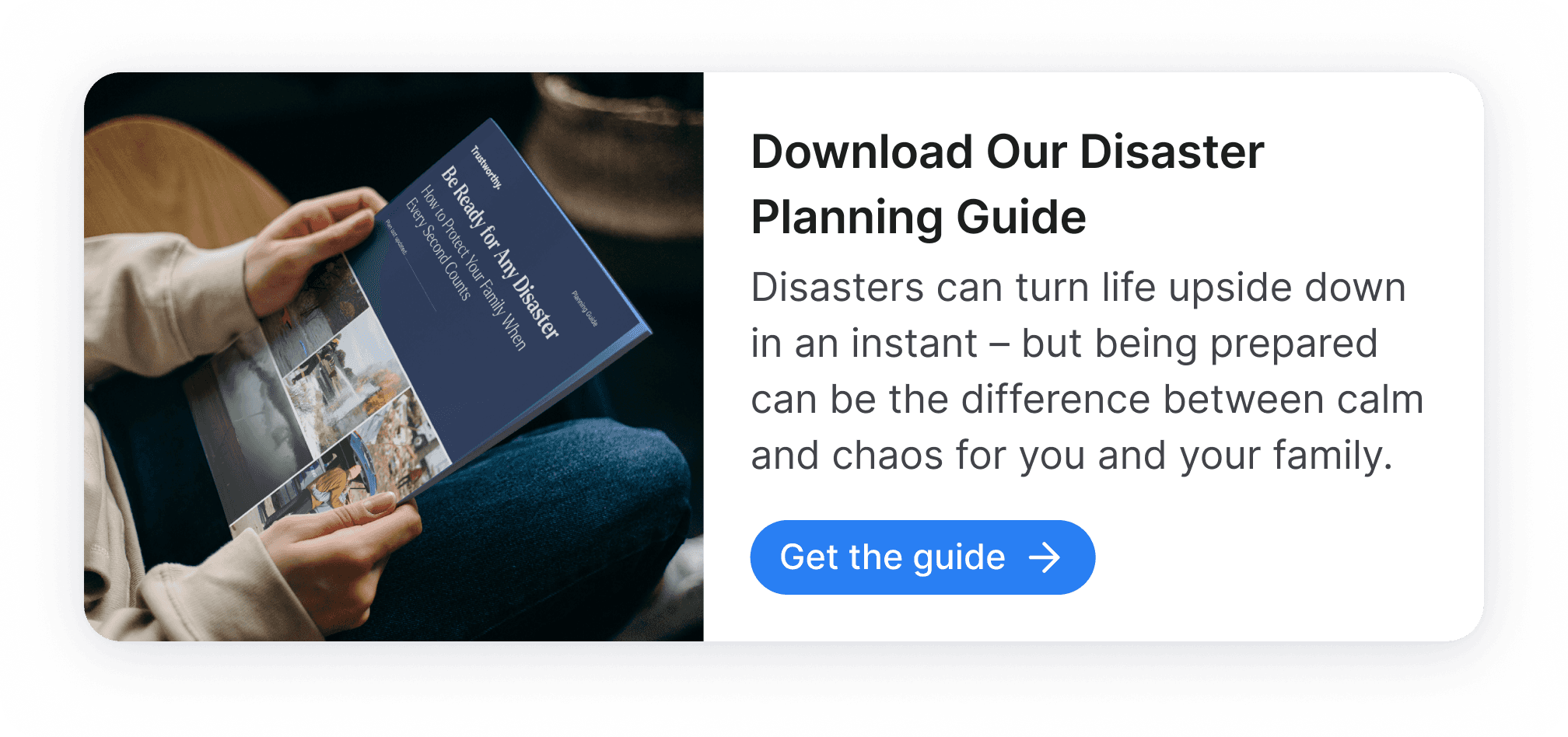
Key Takeaways
Before returning to property after wildfires, ensure it's safe by following official guidance from local authorities, wearing protective clothing including masks, gloves, and sturdy footwear to protect from debris and hazardous materials.
Conduct thorough property inspections looking for structural damage, instability, or hazards like downed power lines and gas leaks, documenting everything with photographs and videos for insurance claims.
Create detailed inventories of damaged or lost items including descriptions, purchase dates, and approximate values to help file accurate insurance claims and apply for disaster assistance.
Contact insurance providers immediately to start claims processes, providing gathered documentation and keeping records of all communications, with Trustworthy allowing secure storage and easy retrieval of policies and contact details.
Financial assistance is available through organizations including FEMA (grants for temporary housing and home repairs), SBA (low-interest disaster loans), and Red Cross, with digital document storage in Trustworthy streamlining claims processes.
Wildfires can leave a trail of devastation in their wake, affecting not only the landscape but also the lives of those who call the affected areas home. As you return to your property after a wildfire, it's crucial to have a comprehensive plan to assess damage, document losses, and access resources for financial and emotional support.
This guide will help you navigate the post-wildfire recovery process effectively.
Assessing and Documenting Damage
Safety First
Before you begin assessing the damage, ensure that it's safe to return to your property. Follow official guidance from local authorities and emergency services. Wear protective clothing, including masks, gloves, and sturdy footwear, to protect yourself from debris and hazardous materials.
Inspecting Your Property
Start by conducting a thorough inspection of your property. Look for structural damage, including the foundation, walls, roof, and any outbuildings. Check for signs of instability or hazards like downed power lines and gas leaks. Document everything with photographs and videos, which will be important for insurance claims.

Documenting Losses
Create a detailed inventory of damaged or lost items. Include descriptions, purchase dates, and approximate values. This information will help you file accurate insurance claims and apply for disaster assistance. Having these records already stored digitally in Trustworthy will streamline the claims process and help you recover faster.
Contacting Your Insurance Company
Notify your insurance provider as soon as possible to start the claims process. Provide them with the documentation you've gathered and follow their instructions for further steps. Keep a record of all communications with your insurer, including dates, times, and the names of representatives you speak with. With Trustworthy, all your insurance policies and contact details can be securely stored and easily retrieved when needed.
Financial and Emotional Support
Financial Assistance
Several organizations offer financial assistance to wildfire survivors. These include federal and state agencies, non-profits, and community groups. Here are some key resources:
FEMA: The Federal Emergency Management Agency provides grants for temporary housing, home repairs, and other disaster-related expenses.
SBA: The Small Business Administration offers low-interest disaster loans to homeowners, renters, and businesses.
Red Cross: The American Red Cross provides immediate assistance, including shelter, food, and clothing.

Emotional Support
The emotional impact of a wildfire can be profound. It's essential to seek support to cope with stress, anxiety, and grief. Consider the following resources:
Counseling services: Many communities offer free or low-cost counseling for disaster survivors.
Support groups: Join support groups to connect with others who have experienced similar losses.
Hotlines: Crisis hotlines can provide immediate emotional support and referrals to local services.
Community Resources
Engage with your community to access additional resources and support. Local governments, nonprofits, and faith-based organizations often coordinate recovery efforts and can provide valuable assistance. Volunteering in recovery efforts can also be a therapeutic way to regain a sense of control and purpose.

Wildfire Emergency Plan
Preparing for Future Wildfires
To mitigate the risks of future wildfires, it's essential to have a comprehensive wildfire emergency plan. This plan should include:
Evacuation routes: Identify multiple evacuation routes and ensure all family members are familiar with them.
Emergency kit: Assemble a kit with essential supplies, including water, food, medications, and important documents.
Communication plan: Establish a communication plan to stay in touch with family and friends during an emergency.
Home hardening: Implement measures to make your home more resistant to wildfires, such as clearing vegetation and using fire-resistant building materials.
For more detailed guidance on crafting a family emergency plan, read "Crafting a Family Emergency Plan: Essential Elements."

Protecting Important Information
Trustworthy offers solutions to protect and optimize your important family information. By storing documents digitally, Trustworthy helps you quickly access important records, such as insurance policies, medical records, and property inventories, in case of an emergency. Our platform analyzes documents, extracts key information, autofills data, and enables secure collaboration. Features include disaster preparedness and recovery solutions, advance directives, reminders, mobile access, and secure sharing.
Frequently Asked Questions
How do I know when it's safe to return home after a wildfire?
Follow guidance from local authorities and emergency services. They will provide updates on when it's safe to return to your property.

What should I do if I find structural damage to my home?
Document the damage with photographs and videos, then contact your insurance company to start the claims process. Avoid entering structures that appear unstable.
Where can I find financial assistance for wildfire recovery?
Financial assistance is available from federal and state agencies, nonprofits, and community organizations. Key resources include FEMA, the SBA, and the American Red Cross.
What should be included in a wildfire emergency plan?
A comprehensive wildfire emergency plan should include evacuation routes, an emergency kit, a communication plan, and home hardening measures. By storing your important documents in Trustworthy, you can make recovery efforts more efficient and less stressful, ensuring you have quick access to the resources and information you need during difficult times.
We’d love to hear from you! Feel free to email us with any questions, comments, or suggestions for future article topics.














